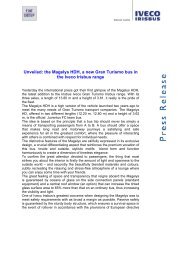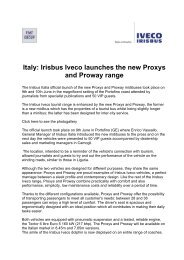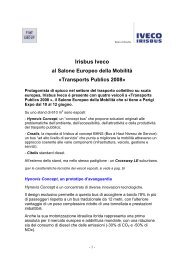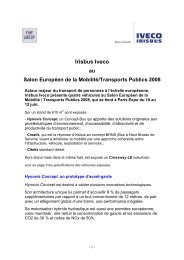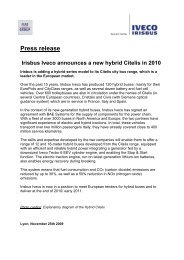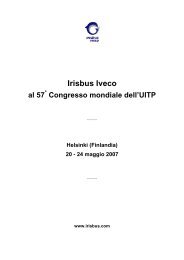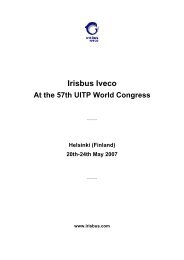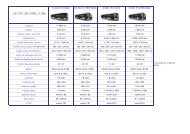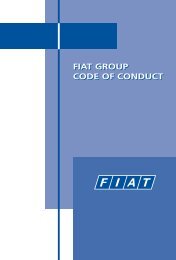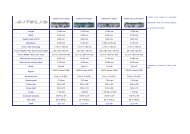You also want an ePaper? Increase the reach of your titles
YUMPU automatically turns print PDFs into web optimized ePapers that Google loves.
<strong>Iveco</strong> <strong>Irisbus</strong><br />
at the<br />
European Mobility Exhibition/Public Transport 2008<br />
<strong>Irisbus</strong> <strong>Iveco</strong>, a major player in passenger transport on a European scale,<br />
presents four vehicles at the European Mobility Exhibition/Transport<br />
Public 2008, which takes place at the Paris Expo from 10 th to 12 th June.<br />
The exhibits on a 610 m 2 stand are:<br />
- Hynovis Concept, a Concept Bus that brings original solutions to the public<br />
transport sector’s problem areas of the environment, accessibility, attractiveness<br />
and productivity;<br />
- Crealis, which is <strong>Irisbus</strong>’ response to the BHNS concept (High Service Level Bus)<br />
aimed at improving mobility by a joined-up approach between infrastructure, vehicle,<br />
operation and services;<br />
- Citelis standard diesel.<br />
A suburban Crossway LE is exhibited away from the stand but in the same hall.<br />
(See page 9 for the specifications of the vehicle exhibits)<br />
Hynovis Concept, an avant-garde prototype<br />
The Hynovis Concept is intended to validate several technological innovations.<br />
Its unique architecture enables it to accommodate 8% more passengers<br />
compared to a conventional 12 metre bus, together with an overall weight<br />
reduction of one ton, an unrivalled performance.<br />
Its hydraulic hybrid power unit is also a European, even a world, first: it reduces<br />
diesel consumption and CO2 emissions by 30%, and NOX emissions by 50%.<br />
- 1 -
The background<br />
Hynovis Concept is the outcome of a French research project launched following a call<br />
for bids by PREDIT (French National Programme for Research and Innovation in Land<br />
Transport), funded by the ADEME (French Agency for Environment and Energy<br />
Management) and the ANR (French National Research Agency), and given the seal of<br />
approval by the Pôle de Compétitivité Lyon Urban Trucks & Bus (Lyon Urban Trucks &<br />
Bus Competitiveness Centre). <strong>Irisbus</strong> <strong>Iveco</strong> is the holder of this project.<br />
Hynovis Concept is the result of a partnership with the RATP (Paris public transport<br />
authority), who defined the operating specifications governing the development of the<br />
project and who carried out the experiments, the INRETS (French National Institute for<br />
Transport and Security Research), who prototyped the hybridization and auxiliary<br />
systems, Michelin, who studied and supplied the tyres, Poclain Hydraulics who studied<br />
and supplied the hydraulic hybridization components, and Altair Engineering France<br />
for the optimisation and structural weight reduction calculation.<br />
The concept was developed on a 12-metre diesel vehicle, an element of the vast<br />
majority of present-day bus fleets.<br />
The originality of Hynovis Concept consists of taking a fresh look at the concept<br />
prevailing up to now with regard to buses.<br />
To improve in particular its environmental performance, Hynovis Concept focused on<br />
the simultaneous correction of two deficiencies:<br />
- reducing its polluting emissions;<br />
- increasing its carrying capacity (so as to divide the emissions by a larger number of<br />
passengers).<br />
This approach is unique, because a characteristic feature of the majority of the hybrid<br />
bus projects suggested at present is a significant increase in the weight of the<br />
vehicles, thus reducing their passenger-carrying capacity.<br />
A substantial weight gain thanks to a special architecture<br />
Hynovis Concept has a twin steering axle fitted with low-profile tyres, allowing the<br />
central corridor to be enlarged to 1200 mm alongside the front wheel housings<br />
(compared to 900 mm for a standard bus).<br />
This configuration greatly eases the movement of passengers at the vehicle entrance<br />
and considerably increases the free flow of the operation, reducing waiting times at<br />
stops. This leads to an increase in running speed, a particularly attractive factor in the<br />
public transport sector, because it is known that the frequency of use of buses<br />
compared to that of the motor car increases greatly when their running speed rises.<br />
Thus the environmental performance which is down to the architecture of the Hynovis<br />
Concept doubles as a result of its increased operating efficiency.<br />
- 2 -
Its four small steering wheels eliminate the front seat access walkways. There is a<br />
double benefit for those with reduced mobility since access to these seats is easier<br />
and the risk of falls during the vehicle’s acceleration and braking stages is reduced.<br />
The drive axle is located under the rear bench, eliminating the wheel housing and<br />
releasing a long platform free from any steps, thus allowing optimum furnishing and a<br />
passenger capacity increased by 8% compared to a standard bus.<br />
Michelin has developed tyres with an improved rolling coefficient especially for the<br />
Hynovis Concept with a three-fold aim:<br />
- responding to the vehicle’s novel architectural concept;<br />
- improving the environmental performance of the tyres;<br />
- allowing a one-ton increase in payload compared to a conventional bus, to increase<br />
passenger capacity.<br />
The load-carrying capacity is improved thanks to the “Michelin Durable Technology<br />
Infini Coil” technology, which enables an 8% reduction in the average rolling<br />
resistance of the tyres.<br />
Hynovis Concept shows a weight reduction of 1 ton despite being equipped with a<br />
hybridization system, thanks to a reduction in the weight of the metal architecture and<br />
the installation of an engine with a smaller cylinder capacity (<strong>Iveco</strong> Tector).<br />
This weight reduction by one ton compared to a conventional bus is one of the major<br />
features of Hynovis Concept, since weight is one of the main causes of overconsumption<br />
by a bus.<br />
This weight gain also allows the carrying capacity to be increased by 9 passengers<br />
according to the standard homologation conditions, which equals 8% of the capacity of<br />
a 12 m bus.<br />
Hydraulic hybridization<br />
Hynovis Concept is fitted with two hydraulic systems: a stop-start starter and a braking<br />
energy recovery system.<br />
The stop-start combines two functions:<br />
- stopping the engine while the bus is stationary, and restarting it rapidly (within 0.3<br />
second) before it moves away again;<br />
- supplying the auxiliary systems while the engine is stopped, using an innovative<br />
electricity storage device via a mixed system combining batteries and supercapacitors.<br />
The braking energy recovery system relies on hydraulic motor-pumps. Linked to a<br />
hydro-pneumatic accumulator, it enables braking energy to be recovered and re-input<br />
during acceleration.<br />
- 3 -
Hydraulic technology was chosen because it currently has a very competitive cost<br />
price compared to competing hybrid technologies, while still showing very similar<br />
efficiency.<br />
A 30% reduction in CO2 emissions<br />
The 30% reduction in CO2 emissions by Hynovis Concept is composed of:<br />
- hydraulic hybridization: - 23% (of which 8% is for the stop-start and 15% for the<br />
motor-pumps);<br />
- 1-ton weight reduction: - 5%;<br />
- tyres with improved coefficient of resistance: - 2%.<br />
As for the emissions of nitrogen oxides, NOx, these are reduced by 50% thanks to the<br />
stop-start.<br />
Visual, acoustic and climatic comfort<br />
To break the psychological barrier that makes using a car preferable, <strong>Irisbus</strong> <strong>Iveco</strong> has<br />
made great efforts to implement an innovative design incorporating exceptionally large<br />
areas of glass.<br />
Lowering the bottom line of the window openings and adding a glazing in the roof (on<br />
the right-hand side of the vehicle) allows a 20% increase in glazed area, providing an<br />
even greater all-round view of the urban landscape.<br />
Significant improvements were made in vibrational and acoustic comfort. Hynovis<br />
Concept is the first bus to be fitted with fully independent, fully steering wheels, both at<br />
the front and at the rear. This solution allows standard turning and swept circle radii to<br />
be maintained despite the increase in the wheel-base.<br />
Comfort is significantly improved thanks to the reduction in the unsprung masses and<br />
the independent damping on the right and left wheels, which reduces vibrations and<br />
shocks inside the vehicle.<br />
The acoustic insulation was given special treatment, made easier by the design of the<br />
rear engine section. The use of an engine with a small cylinder capacity (6 litres)<br />
achieves a reduction of 6 dB in external noise.<br />
An inertial air-conditioning system using a liquid coolant was developed for Hynovis<br />
Concept.<br />
This allows a 50% reduction in the weight of refrigerant fluid and a 25% reduction in<br />
energy consumption by this auxiliary equipment.<br />
This increase in efficiency more than compensates for the increase in the vehicle’s<br />
window area.<br />
- 4 -
<strong>Irisbus</strong> <strong>Iveco</strong>’s reply to the BHNS concept: Crealis<br />
Urban transport is undergoing a profound change. Having become an instrument of<br />
urbanisation and social harmonization, it occupies a place at the heart of the problems<br />
of future sustainable urban development.<br />
The concept of the BHNS (High Service Level Bus), a real way to smarten up and<br />
enhance the value of an urban transport network, is a candidate for a strategic choice<br />
for a town to make in favour of a global system rather than just an investment in rolling<br />
stock.<br />
In this context <strong>Irisbus</strong> <strong>Iveco</strong> has developed Crealis, based on the Citelis bus, to<br />
provide a solution that is both innovative and competitive:<br />
• for service, optimising the idea of comfort and passenger information in a modern,<br />
welcoming interior atmosphere;<br />
• with a strong image of a vehicle with a personalised design and profiting from<br />
being very easy to fit into a town.<br />
Crealis is designed for use in traffic on a dedicated site (bus lane) or on a potentially<br />
high passenger volume route, considerably improving the quality of service<br />
(frequency, passenger flow, regularity). The development of dedicated sites or high<br />
volume routes is the essential key to better mobility. Freed from motor car congestion,<br />
the vehicles consume less, improve their environmental performance, provide superior<br />
comfort to the customers, and, above all, offer a much better running speed that is<br />
likely to draw car users towards public transport.<br />
Crealis is developed and industrially manufactured entirely by <strong>Irisbus</strong> <strong>Iveco</strong>.<br />
The vehicle’s personalisation takes concrete shape:<br />
- on the front surface as a straight windscreen (from the Citelis bus) or a special<br />
sloping windscreen (here, the vehicle is called the Crealis Neo);<br />
- through the following optional fittings: wheel-covers, glazed low-level windows<br />
gaining an additional opening on the town, and optical guidance developed in<br />
conjunction with Siemens Transportation System.<br />
A superior quality service<br />
Compared to a standard route bus, Crealis unquestionably represents a noticeable<br />
leap forward in quality that strengthens its image and is immediately recognizable as a<br />
superior quality service. Its performance immediately appears to be higher because its<br />
external shapes suggest dynamism and free flow and convey the idea of travel that is<br />
faster, more regular and more reliable.<br />
This level of performance is combined with a superior level of comfort. On board,<br />
Crealis offers a welcoming layout that is roomy and well-lit, a good opportunity to sit<br />
down and relax. The use of quality-enhancing materials that are warm and natural,<br />
such as wood, contrasted with high-tech notes such as metallic grey and metallic<br />
charcoal grey, provides an atmosphere that is both stimulating and calming at the<br />
same time.<br />
- 5 -
Crealis was developed around concerns about accessibility for all. Its floor is low and<br />
flat throughout and it is fitted with sliding doors, allowing better free flow for those<br />
entering/alighting, while at the same time improving accessibility for persons of<br />
reduced mobility, passengers with a push-chair, wheelchair users, etc.<br />
It can be fitted with a Siemens optical guidance system that guarantees optimum<br />
precision when pulling up at stops.<br />
Crealis offers travellers maximum comfort at off-peak times and reduced discomfort<br />
during rush hour, thanks to a variety of passenger positions and thus postures, which<br />
enables them to optimise the combination of journey time/use of this time/place in the<br />
vehicle. The standing room has greater value, not as space remaining when all the<br />
seats are full, but as a zone occupied voluntarily and by choice to enable a<br />
supplementary activity to be carried out (reading, face-to-face or phone conversation ,<br />
using a personal communication device, listening to music, etc.).<br />
To benefit more fully from the town and public space, Crealis can be fitted with glazed<br />
roof hatches and additional windows in the vehicle’s lower sides, as well as other<br />
layouts supplying yet more light.<br />
Crealis incorporates various forms of information media (static and dynamic, visual<br />
and audible), enabling passengers to improve their journey organisation and to better<br />
anticipate their stop, but also to inform them of the nature of possible traffic problems,<br />
the effects on their journey, and opportunities to continue their journey.<br />
For those organising authorities and urban networks who want to avail themselves of<br />
environmental performances that are higher than just the regulations currently in force,<br />
Crealis can be fitted with an EEV (Enhanced Environmentally Friendly Vehicle) power<br />
unit whose outstanding environmental footprint is above that of Euro 5 which will come<br />
into force in 2009. Crealis is also designed to incorporate new clean forms of energy<br />
as and when these are implemented.<br />
Nîmes, Paris and Maubeuge choose Crealis<br />
The Nîmes BHNS (High Service Level Bus) will be operational in 2010. It will consist<br />
of a 6 km route operated by eight articulated Crealis.<br />
The Maubeuge BHNS comprises three routes totalling 28 km. The first of them will<br />
come into service in December 2008. The plan is to use eighteen 12 metre Crealis<br />
and two articulated Crealis.<br />
- 6 -
For the contract signed with <strong>Irisbus</strong> <strong>Iveco</strong> to supply 120 to 170 articulated buses, the<br />
RATP specified a High Service Level variant that will be deployed to promote and<br />
work in conjunction with certain bus network development projects. This variant will<br />
incorporate the most innovative technologies in the passenger information area.<br />
Particular care has also been devoted to the interior design and comfort of this<br />
vehicle, as well as to its exterior design, particularly as a result of a special livery to<br />
enhance the value of the service offered to passengers compared to a standard bus<br />
route. Through an increase in running speed, greater frequency, improved regularity<br />
and punctuality and an increase in the hours of service, which will enable better<br />
connection with other transport systems, the BHNS represents for the RATP a<br />
genuine response to the needs of passengers and regions.<br />
Note: The photo of the RATP BHNS attached to this press release (cf. the “Photos” file) shows a<br />
vehicle whose livery is a style study and does not correspond to the final version.<br />
N.B.: See also the specific file “BHNS Design” attached to this press release.<br />
Citelis, a complete range for every need<br />
So much effort which is quite naturally in keeping with a viewpoint of sustainable<br />
development and environmental conservation.<br />
With its Citelis range, <strong>Irisbus</strong> <strong>Iveco</strong> offers authorities organising public transport, and<br />
operators, a very wide range of choice between:<br />
- a standard bus (12 m), an articulated bus (18 m) and a short version (10.50 m);<br />
- various energy sources: Euro 4 and Euro 5 diesel engines, EEV, natural gas<br />
engine, electric motive power.<br />
In the diesel version, these vehicles with an exceptional environmental balance sheet<br />
already correspond (as an option) to the European EEV label which is already beyond<br />
the Euro 5, set to come into force in 2009.<br />
The CNG (Compressed Natural Gas) version of the Citelis represents today’s true<br />
clean alternative to diesel while waiting for future technologies such as the fuel cell.<br />
Being “cleaner”, when natural gas is burnt it emits less carbon monoxide than diesel,<br />
no sulphur oxide and very little nitrogen oxides.<br />
<strong>Irisbus</strong> <strong>Iveco</strong> has been active in natural gas technology for about fifteen years and<br />
confirms its position as leader with close to 4000 CNG buses sold worldwide.<br />
Very large fleets have been built up in France, Italy, Spain and Greece.<br />
Due to its stoichiometric technology, the <strong>Iveco</strong> Cursor 8 CNG engine emits a<br />
particularly reduced level of emissions, conforming to a large extent to the European<br />
EEV (Enhanced Environmentally Friendly Vehicle) label.<br />
The very low noise level of the <strong>Irisbus</strong> <strong>Iveco</strong> natural gas bus is appreciated both by<br />
passengers and by the public.<br />
In its different versions, Citelis is recording a very great success in Europe and is<br />
making a decisive contribution to the position of co-leader that <strong>Irisbus</strong> <strong>Iveco</strong> occupies<br />
on the urban markets of the enlarged Europe of 27 countries, with a penetration of<br />
17.9% in 2007.<br />
- 7 -
Crossway LE, the low-entry suburban and inter-city vehicles<br />
Crossway LE, the Low Entry version of the Crossway intercity coach, is available in<br />
two lengths: 12 m and 12.80 m.<br />
The Crossway LE, a low-floor bus at the front and a high-floor coach at the rear, is a<br />
vehicle that is particularly well positioned in terms of quality/price ratio to meet,<br />
according to the markets, the needs of suburban or inter-city transport requiring a<br />
mixture of “high accessibility / maximum capacity in seating”.<br />
The footboards at the front and centre are 320 and 330 mm respectively from the<br />
ground, guaranteeing perfect accessibility to enter and alight from the vehicle,<br />
especially for passengers with reduced mobility. This front section enjoys an interior<br />
height of 2.565 m; it can be configured in terms of seats/standing room depending on<br />
the operator’s needs. As an option, the central entrance can be equipped with a<br />
retractable ramp to simplify access for a wheelchair user.<br />
After the centre door, two inside steps allow access to the rear section, whose floor is<br />
at a height of 980 mm from the ground; this section accommodates only seated<br />
places. The minimum interior height is 1.925 m.<br />
Various front and centre door options are offered: a simple 800 mm door with one or<br />
two door leaves, or a 1200 mm two-leaf door.<br />
If there is a rear door, this provides a width of 800 mm and is available with one or two<br />
leaves.<br />
The <strong>Iveco</strong> Tector or Cursor Euro 4 engine (Euro 5 or EEV as an option), gearbox<br />
(manual or automatic), rear axle, brakes and instrument panel of the Crossway LE are<br />
identical to those of the Crossway coach, while the independent suspension front axle<br />
and steering are borrowed from the Citelis bus. This standardisation of mechanical<br />
components optimises reliability and economy of operation.<br />
Paris, 10 th June 2008<br />
- 8 -
Description of the vehicles exhibited<br />
HYNOVIS<br />
Length 12 m<br />
Engine Tector 6 Diesel EEV<br />
Power 162 kW - 220 hp<br />
Gearbox Voith 6-speed<br />
Places 18 seated places<br />
CREALIS<br />
Length 18 m<br />
Engine Cursor 8 Diesel Euro 5<br />
Power 280 kW - 380 hp<br />
Gearbox ZF or Voith<br />
Places 30 seated places + 1 location for a wheel-chair user<br />
CITELIS 12<br />
Length 12 m<br />
Engine Cursor 8 Diesel Euro 5<br />
Power 213 kW - 290 hp<br />
Gearbox ZF or Voith<br />
Places 26 seated places + 1 location for a wheel-chair user<br />
CROSSWAY LOW ENTRY<br />
Length 12 m<br />
Engine Cursor 8 Diesel Euro 5<br />
Power 243 kW - 330 hp<br />
Gearbox ZF or Voith<br />
Places 45 seated places + 1 location for a wheel-chair user<br />
______<br />
- 9 -
<strong>Iveco</strong><br />
<strong>Iveco</strong> designs, manufactures, and markets a broad range of light, medium and<br />
heavy commercial vehicles, off-road trucks, city and intercity buses and coaches<br />
under the <strong>Irisbus</strong> brand as well as special vehicles for applications such as fire<br />
fighting, off-road missions, defence and civil protection.<br />
<strong>Iveco</strong> employs over 26,000 people and runs 27 production units in 16 Countries<br />
in the world using excellent technologies developed in 5 research centres.<br />
Besides Europe, the company operates in China, Russia, Australia, Argentina,<br />
Brazil, and South Africa.<br />
More than 4,600 service outlets in over 100 Countries guarantee technical<br />
support wherever in the world an <strong>Iveco</strong> vehicle is at work.<br />
For any additional information, please contact<br />
Nicolas TELLIER<br />
<strong>Irisbus</strong> Press Relations<br />
Tel.: +33 (0) 1 30 66 81 46<br />
E-mail: nicolas.tellier@irisbus.iveco.com<br />
- 10 -



